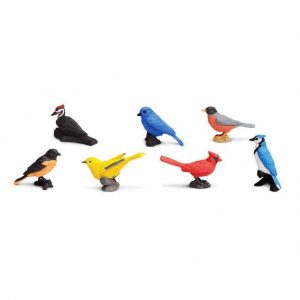The Montessori Three-Period Lesson
In their first few years of life, children have one job they take very seriously: learning everything they can about the nature, culture, and language of the world around them. They absorb this information like sponges and ask countless questions to differentiate between the many things they have to learn. During this curious phase, the Montessori three-period lesson is a helpful tool that parents and teachers can use to teach the many concepts their children crave to learn.
In this article, we’ll break down everything there is to know about the Montessori three-period lesson so you can begin implementing this simple, effective tool today.

What Is the Montessori Three-Period Lesson?
The Montessori three-period lesson is a simple, three-step process of teaching children new information. It involves the adult introducing a concept and the child recognizing and eventually recalling it.
A basic three-period lesson looks like this:
First period: “This is [x].”
Second period: “Can you show me [x]?”
Third period: “What is this?”
How to Use A Montessori Three-Period Lesson
The Montessori three-period lesson starts with preparing the concepts you plan to introduce to your child. This preparation may also include gathering the necessary materials, like sandpaper letters, language miniatures, or grammar symbols. Usually, a three-period lesson is done with 2-3 related words or concepts.
Once you have prepared the necessary materials, invite your child to sit with you. A mat is useful to contain the activity and give your child a defined workspace. Once your materials are prepared and your child is ready to learn, it’s time to start the first period.
Period 1: Naming
 The first period is naming. The adult simply names each word or concept. For example, if you’re using a three-period lesson to teach your child the species of three backyard birds, you can take each backyard bird language object and name them one at a time. “This is a blue jay,” “This is a northern cardinal,” “This is an American robin.”
The first period is naming. The adult simply names each word or concept. For example, if you’re using a three-period lesson to teach your child the species of three backyard birds, you can take each backyard bird language object and name them one at a time. “This is a blue jay,” “This is a northern cardinal,” “This is an American robin.”
Keep your introductions simple and brief. This isn’t the time to tell your child facts about the birds or discuss their features. The goal is to simply introduce each concept in a way that makes it easy for your child to remember.
Period 2: Recognition
In the second period, the adult asks the child to recognize the new concept or vocabulary. It’s best to start with the last concept named in the previous period. Since the last-named concept is the freshest in the child’s memory, it’s easiest for them to recognize, and doing so builds their confidence.
Continuing on the example above, this may sound like, “Can you point to the American robin?” “Can you point to the blue jay?” “Can you point to the northern cardinal?”
Period 3: Recall
In the third period, the adult makes sure the child has retained the information. This may look like holding or pointing to a bird figure and asking, “What bird is this?”
The goal of the recall period is to help the adult understand what the child has retained and what needs more work. If there’s anything a child doesn’t quite remember, the process starts again from the first period.
The Benefits of Using The Montessori Three-Period Lesson
The three-period lesson teaches children new concepts in a simple, developmentally appropriate way.
Three-period lessons use minimal language. The adult isn’t lecturing a child or going into great detail about a concept. They’re simply stating what it is and ensuring the child understands before moving on. This approach helps children stay engaged and attentive in the learning process and keeps them from feeling overwhelmed.
Three-period lessons are fantastic for helping children differentiate between related words and concepts. It can be confusing to remember animal species, parts of the body, or letters when the words or ideas seem similar to each other. Placing each of these concepts together and simply differentiating between them in a three-period lesson can help children better see and remember the differences.
The identification and recall periods allow the adult to gauge the child’s understanding without drilling or pressuring them. This helps the adult to know exactly which concepts have been mastered and which need a little more work. Recalling also taps into a child’s higher-order thinking skills, according to this article on how memory works in kids.
When to Use A Three-Period Lesson
 The Montessori three-period lesson can be used to teach anything! The most obvious uses may be in presenting authentic materials like geometric solids, number rods, or Montessori language materials. A three-period lesson is also a great tool when introducing new vocabulary. However, the three-period lesson isn’t limited to these uses.
The Montessori three-period lesson can be used to teach anything! The most obvious uses may be in presenting authentic materials like geometric solids, number rods, or Montessori language materials. A three-period lesson is also a great tool when introducing new vocabulary. However, the three-period lesson isn’t limited to these uses.
If you’re playing outside on a fall day and see a few different types of leaves scattered in the grass, a three-period lesson would be a perfect way to teach your child the difference between oak, poplar, and aspen leaves. If you’re reading a book about construction trucks with your truck-loving toddler who can’t quite differentiate between a backhoe loader and an excavator, a three-period lesson can help.
Share With Us
The Montessori three-period lesson is a simple, versatile tool to keep handy in your parenting toolbox. While these lessons are widely used in Montessori classrooms, they don’t need to be as formal as sitting down during designated school time and presenting a lesson. These lessons can also be a casual way to help your child understand new information wherever and whenever they may be learning it.
Have three-period lessons been an effective tool in your family? We’d love to hear more about it! Let us know in the comments below.




0 Comments